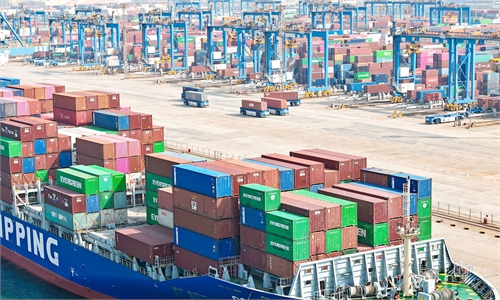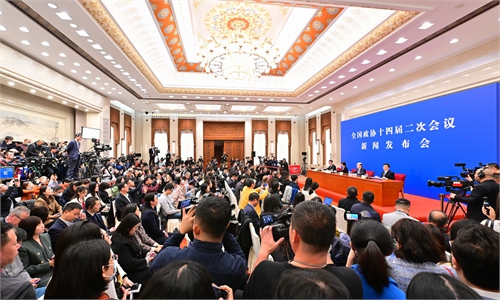Why do foreign groups target Chinese economy as the ‘anchor’?: Global Times editorial

Illustration: Tang Tengfei/GT
Many overseas institutions and media have noticed the recent rebound in China's consumer price index (CPI) and have positively evaluated the stabilizing policies implemented by the Chinese government. It seems as if the "warmth" of the Chinese economy has suddenly spilled over into other countries. This indicates that after a period of multiple efforts, the "internal force" of China's economic recovery has been preliminarily released. At the same time, the international market, in a state of confusion, needs an "anchor," thus increasing the in-depth study of the trend of the Chinese economy.Since the second half of last year, some overseas institutions and media have been pessimistic about the trend of China's economic recovery, with some even predicting deflation in China. In February of this year, China's CPI rose by 1.0 percent month-on-month, while the Producer Price Index (PPI) fell by 2.7 percent year-on-year, an increase of 2.7 percentage points compared to the largest decline of 5.4 percent in June last year. As these two indicators continue to improve, overseas media have also adjusted their views. For example, the Chinese website of the Wall Street Journal evaluated the export trend of the first two months of China as having strong momentum, stating that the growth rate far exceeded the 3 percent expected by economists earlier. Deutsche Welle also said surprisingly strong export growth has made outsiders feel optimistic about China's economic growth target of around 5 percent.
We welcome this change, but we also need to appreciate its deeper meaning. On the one hand, some overseas institutions and media are deeply influenced by traditional Western political economy, and they tend to make methodological errors by using inflexible approaches when analyzing economic issues. Some overseas institutions and media also view the Chinese economy through "colored glasses," reacting slowly to positive signals. On the other hand, the development trend of the real economy is formed through continuous accumulation. After the trend is formed and consolidated, any unbiased person will respect the real data, and overseas institutions and media adjusting their views is normal and expected.
More importantly, we have our own expectations for the positive trend of China's economic recovery. Our expectations are, firstly, based on the huge size of the domestic demand market; secondly, based on the most complete manufacturing supporting system in the world; thirdly, based on a more mature mechanism for external cooperation and a more convenient and friendly business environment; and fourthly, based on sufficient policy tools and development resources that can be mobilized in the future. All these factors support the positive development of the economy, and are closely related to China's institutional advantages. We can coordinate various economic and social policies, mobilize market entities to overcome difficulties together, formulate and implement targeted measures more efficiently. Furthermore, we can also seize favorable time windows, strengthen coordination between regions, leverage the driving role of economic powerhouse provinces, and stimulate the backbone role of large enterprises.
The forward-looking and targeted adjustments made at the policy level are yielding good results. In the face of a sluggish global economy, the Chinese government proposed a new development pattern of "dual circulation" in July 2020, in which domestic and foreign markets reinforce each other, with the domestic market as the mainstay. Amid declining global trade, sluggish growth and rising protectionism, China has been determined to vigorously cut taxes and fees, and protect and stimulate the vitality of market players through internal policy adjustments. Meanwhile, China intensified the support of fiscal and monetary policies and industrial policies, and realized the upward transformation of the economy from the bottom. In this process, we have maintained both strategic determination and strategic balance.
The CPI indicator, which is of great concern to other countries, is important and, to a certain degree, represents the dynamism of the economy. However, we should look at economic phenomena more systematically. The global economic slowdown is an indisputable fact, and the statistics published by UNCTAD shows that, although global foreign direct investment achieved overall growth last year, it actually declined by 18 percent if several investment transit points are excluded. This data fell by 12 percent year-on-year in 2022. From 2020 to the present, China's attraction of foreign investment has continuously maintained the scale of one trillion yuan, and this figure in 2023 is at the third highest level in history.
The earlier analyses on the size of foreign investments and the number of international tourists conclude that China's degree of openness and the effect of openness have been reduced, which is a misunderstanding. Due to the global trade contraction and the "scarring effect" of the COVID-19 pandemic, it will take time to restore the scale of the outward-oriented economy, and China will further take initiatives to expand its openness.
Recently, China has launched a series of policies, such as the issuance of ultra long-term special government bonds, implementing trade-in of consumer goods and large-scale equipment renewals among others. These measures, like the expansion of opening-up, are aimed at improving the quality of economic development and people's living standards. With the mutual reinforcement of expanding domestic demand and stabilizing external demand, the potential vitality of China's mega-market will be better released, and China will continue to play an important role as a tractor and contributor to the global economy.



